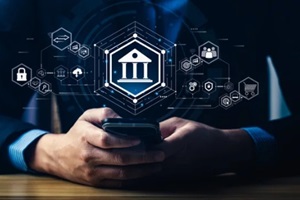 Sixty-five percent of U.S. businesses experienced actual or attempted payment fraud in 2022. Recovering stolen funds is challenging, with only 27% of the victims recouping 75% or more. Consequently, it is essential to implement cybersecurity measures to protect your business checking account in Maryland.
Sixty-five percent of U.S. businesses experienced actual or attempted payment fraud in 2022. Recovering stolen funds is challenging, with only 27% of the victims recouping 75% or more. Consequently, it is essential to implement cybersecurity measures to protect your business checking account in Maryland.
We will explain how to reduce the risk of cybersecurity threats such as phishing attacks so you can safeguard the account.
Follow the Best Practices for Password Selection and Management
Poor password selection has been a significant cause of data breaches since 2019, according to the Verizon Data Breach Investigations Report. Cybercriminals effortlessly crack weak passwords, and once they do, they access bank accounts and other sensitive information.
Hence, following the best practices for setting passwords for business checking accounts in Maryland is imperative. According to a Google/Harris Poll, 59% of Americans use names or birthdays, and 24% include common words, such as “password” and “abc123,” when creating passwords.
Such passwords are susceptible to brute force attacks, where the cybercriminal uses trial and error to breach the account. Furthermore, 66% of adults use the same password on two or more online accounts, creating a risk of credential stuffing attacks.
Cybercriminals purchase stolen credentials on the dark web and use them to access additional accounts owned by the same individual. Many individuals do not realize their information has been compromised until a cybercriminal breaches their bank accounts.
For the best protection, choose a long phrase that contains multiple words, numbers, and special characters while avoiding common words and personal information. Update the password every three months using the same strategies to protect the account.
Enable Multi-Factor Authentication (MFA) on the Checking Account
At a minimum, banks verify usernames and passwords before granting access to accounts, but those who want enhanced security also enable multi-factor authentication. Once activated, members provide login credentials before undergoing a second type of verification.
Financial institutions employ assorted options for MFA, including PIN and phone verification. MFA vastly improved security,blocking up to 99.9% of automated cyberattacks.
Activate Account Notifications
Along with implementing security measures, account holders should actively monitor their accounts for suspicious activity.
Activate account notifications and contact the financial institution if suspicious activity is detected. The bank will immediately freeze your account to prevent additional fraudulent transactions.
Limit Account Access
 Allowing all employees access to your business checking account creates a significant security risk. Instead, only grant access to those who need to use the account for business purposes, such as paying vendors or employees.
Allowing all employees access to your business checking account creates a significant security risk. Instead, only grant access to those who need to use the account for business purposes, such as paying vendors or employees.
If an employee with access leaves the company, change the password to prevent that person from logging into the account.
Secure the Network and Computers
Cybercriminals who breach a company’s network or computers gain access to all information, including bank account login credentials. Secure the network by setting up a firewall, installing encryption software, and password-protecting the router.
All computers should also have anti-virus software that is configured to update automatically. Follow the same security protocols when logging into the checking account off-site. Otherwise, cybercriminals can find vulnerabilities and gain access to the network.
Train Employees to Detect Phishing Emails
According to the FBI Internet Crimes Report ,336 Maryland residents fell victim to phishing scams in 2022, costing $114,515. Small businesses are often targets of phishing attacks, and unwitting employees can give them access to the company’s bank account and other protected information.
Properly training employees to identify phishing emails is a wise risk mitigation strategy for employers. Phishing emails typically include spelling and grammatical errors, generic greetings, and urgent requests to provide information.
Employees can also identify phishing emails by looking at the sender’s domain address. Cybercriminals use domain names similar to but not the same as the company they are impersonating.
Employees still unsure if the correspondence is from a cybercriminal or a legitimate company should call the sender. Do not use the phone number in the email since it may belong to a cybercriminal.
Instead, train employees to use phone numbers already on file or listed on legitimate websites.
Select a Bank That Is Committed to Security
 Business owners should partner with banks that prioritize account security. Such banks use firewalls and encryption software to prevent cyberattacks.
Business owners should partner with banks that prioritize account security. Such banks use firewalls and encryption software to prevent cyberattacks.
Constant surveillance is also a method employed by banks that value security. Maintaining surveillance ensures that breaches are identified and addressed immediately.
Secure Your Business Checking Account in Maryland at Woodsboro Bank
Woodsboro Bank offers advanced security for all banking products, including business checking accounts in Maryland. With constant surveillance, firewalls, data encryption, and other cybersecurity methods, we prioritize account safety for all clients.
Contact Woodsboro Bank today to find out how we will keep your account secure. We can also discuss our business checking products and help you set up a new account today.